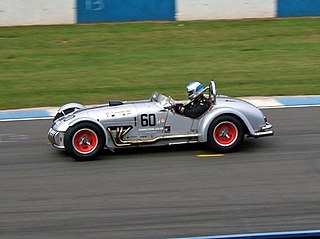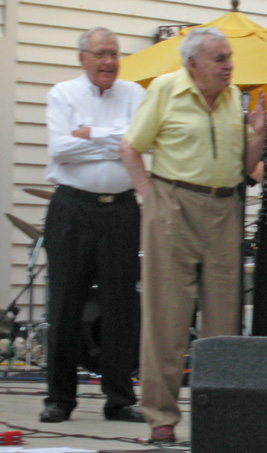
Anthony Joseph Foyt Jr. is an American retired auto racing driver who has raced in numerous genres of motorsports. His open wheel racing includes United States Automobile Club Champ cars, sprint cars, and midget cars. He raced stock cars in NASCAR and USAC. He won several major sports car racing events. He holds the USAC career wins record with 159 victories, and the American championship racing career wins record with 67.

Roger McCluskey was an American IndyCar driver. He was from Tucson, Arizona.

Midget cars, also speedcars in Australia, is a class of racing cars. The cars are very small with a very high power-to-weight ratio and typically use four cylinder engines. They originated in the United States in the 1930s and are raced on most continents. There is a worldwide tour and national midget tours in the United States, Australia, and New Zealand.

Rodger Morris Ward was a World War II P-38 aviator in the United States Army Air Forces, and an American race driver with 26 victories in top echelon open-wheel racing in North America, two Indianapolis 500 victories, and two USAC National Championships, who conceived the classic tri-oval design and layout of Pocono International Raceway, modeled after his three favorite signature turns, at Trenton, Indianapolis and Milwaukee.
Frank Peter Kurtis was an American racing car designer. He designed and built midget cars, quarter-midgets, sports cars, sprint cars, Indy cars, and Formula One cars. He was the founder of Kurtis Kraft.

Kurtis Kraft was an American designer and builder of race cars. The company built midget cars, quartermidgets, sports cars, sprint cars, Bonneville cars, and USAC Championship cars. It was founded by Frank Kurtis when he built his own midget car chassis in the late 1930s.

Troy Lynn Ruttman was an American race car driver. He was the older brother of Jimmy Ruttman, and NASCAR driver Joe Ruttman.

William John Vukovich Sr. was an American automobile racing driver of Serbian descent. He won the 1953 and 1954 Indianapolis 500, plus two more American Automobile Association National Championship races, and died while leading the 1955 Indianapolis 500. Several drivers of his generation have referred to Vukovich as the greatest ever in American motorsport.
Don Edmunds was an American racecar driver and car builder.
Johnnie Woodrow Parsons was an American race car driver from Los Angeles, California who won the Indianapolis 500 in 1950.

Marshall Pleasant Teague was an American race car driver nicknamed by NASCAR fans as the "King of the Beach" for his performances at the Daytona Beach Road Course.

Mel Kenyon is a former midget car driver. He is known as the "King of the Midgets", "Miraculous Mel" and "Champion of Midget Auto Racing." The Motorsports Hall of Fame of America says "Many consider him to be midget car racing's greatest driver ever."

Richard Frank Vogler was an American champion sprint car and midget car driver. He was nicknamed "Rapid Rich". He competed in the Indianapolis 500 five times, and his best finish was eighth in 1989.

Gary Bettenhausen was an American midget car driver. He was the winner the 1967 and 1970 Turkey Night Grand Prix, the 1972 Astro Grand Prix, and the 1976 Hut Hundred

Duane C. Carter Jr., nicknamed "Pancho", is a retired American race car driver. He is most famous for his participation in CART Indy car races. He won the pole position for the 1985 Indianapolis 500, finished third in the 1982 race, and won the 1981 Michigan 500.

John Wayne Parsons is an American race car driver. He is the son of 1950 Indianapolis 500 winner Johnnie Parsons. He drove Indy cars in the USAC National Championship, and also drove USAC championship dirt cars. Parsons made twelve starts at the Indianapolis 500, with a best finish of 5th in 1977 and 1985.

Christopher Constantine Economaki was an American motorsports commentator, pit road reporter, and journalist. Economaki was given the title "The Dean of American Motorsports Journalism." He was an inductee of several halls of fame, including the Motorsports Hall of Fame of America, National Sprint Car Hall of Fame & Museum, and Indianapolis Motor Speedway Hall of Fame.
Larry Rice was an American racing driver in the USAC and CART Championship Car series. He was the 1973 USAC National midget driver's champion and won the USAC Silver Crown series in 1977 and 1981. He was inducted in the National Midget Auto Racing Hall of Fame in 1993.

Bryan Clauson was an American professional auto racing driver. Best known for his achievements in dirt track open-wheel racing, such as USAC Silver Crown, Midget and Sprint cars. Bryan was seen more and more competing with the World of Outlaws (WoO) sprint cars in his last couple of years. Clauson was a dirt track icon who also competed in the NASCAR Nationwide Series, Indy Lights, and IndyCar Series and was a development driver for Chip Ganassi Racing.
Perry Grimm was an American racecar driver who raced midget cars in California and Australia.














